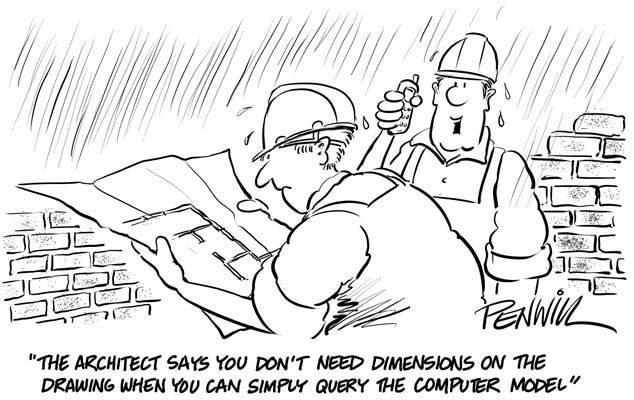Scrolling through LinkedIn the other day I saw a funny cartoon posted in one of the groups I am a member of. With the associated text being, "Who is at Fault, the Architect or the Contractor?
Here is a copy of the image, so you can decide for yourself.

As soon as I saw the post, I formed my opinion very quickly, and I would love to be in the head of the artist, and to see the context that accompanied this clever image. So, without the additional context, I decided I should jot down my thoughts, to foster further discussion in the industry.
The big problem
In the 20 years, I have been in the Architectural Profession, not once have I seen any of my peers sit down at a table and discuss with the receivers of our information, how they want it delivered. Personally, I believe that if a small amount of time was taken to have that conversation, we would see a slight change in the deliverables that we create and provide to the supply chain. I don’t think that it would be a significant change, but the change would make for better outcomes for the receivers.
Then along comes BIM
As the industry shifts towards a digital approach and the concept of building virtual models is becoming the norm, people in the industry are beginning to believe that if they provide a model to their collaborators everything will be solved. This could not be any further from the truth! The false sense that a model solves everything around communication, and digestion of information is concerning me more and more each and every day. A model doesn’t solve everything, and not everyone has the ability or need to use a model to perform their role in the delivery and maintenance of a built asset.
Most of the information needed by the various actors in the process needs written information, despite the concept of a picture being 1,000 words. A BIM isn’t the answer to everything.
Information Requirements and Level of Information Need
It is going to be hard still moving into the future, where on traditional contract types of design, bid and build, the contractor is not engaged when the design consultants are engaged, and their specific information requirements are not captured and included in the scope of works or deliverables on any specific project.
In collaborative contract forms, we will hopefully see the end of comments raised in the cartoon, as all of the information requirements of the delivery team is incorporated into the scope of work, and only the information that is required is produced and delivered, in the format requested. It will reduce waste in creation, but also reduce the time taken to piece disparate pieces of information together to gain the right understanding to perform a responding task.
As an Architect say you are still working on projects delivered under traditional contracts. Maybe it would be wise to sit down with your specialist consultants and contractors you work with and gain an understanding of how they would like to receive information. Document the process and changes, you might be pleasantly surprised that several of the documents you currently produce have little to no value. You might also find that you can produce a few additional deliverables that are really easy to extract from your model, to make the process so much easier.
All it takes is a moment to sit down and ask, rather than assume you know best!






